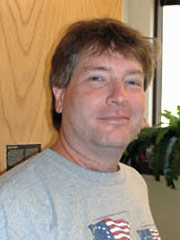-
Daniel C. Devor, Ph.D.
Professor
Tel: 412-383-8755
Fax: 412-648-8330
Address: S328 BST-South
dd2@pitt.edu
CBP Research Group(s):
Regulation of Channels and Transporters
Membrane Trafficking and Organelle Biogenesis
CBMP Graduate Program Groups:
Cell Communication, Signaling and Ion Channel Biology
Genomics, Proteomics and Metabolomics
PubMed pub. listing
-
-
Research
The primary research interest of my lab is in defining the molecular mechanisms involved in the assembly, trafficking, localization and second-messenger-dependent regulation of the intermediate (IK) and small (SK) conductance, Ca2+-dependent K+ channels. These channels are crucial in a wide array of physiological processes, including endothelial function and hence vascular tone, the regulation of action potential firing frequency, epithelial ion transport, cell growth and differentiation and T-cell activation. We currently have 3 main foci in the lab. First, we are using patch-clamp methodologies in combination with variance analysis, computer modeling and mutagenesis to further define the Ca2+-dependent gating processes of these channels. Second, we are using a combination of protein biochemical and fluorescence imaging techniques to study the endocytic trafficking, recycling and ubiquitin-mediated degradation of these channels both in heterologous (HEK cells) and endogenous (human microvascular endothelial cells) expression systems. Finally, we are studying the physiological role of the SK3 homologue in C. elegans using both knockout and transgenic worms as well as expressing the individual splice variants of this channel heterologously to obtain a clearer biophysical fingerprint of these channels.
-
Publications
- Bailey, M.A., M. Grabe and D.C. Devor. Characterization of the PCMBS-dependent modification of KCa3.1 channel gating. J. Gen. Physiol. (in press), 2010.
- Balut, C.M., Y. Gao, C. Luke and D.C. Devor. An immunofluorescence-based assay to identify modulators of the number of plasma membrane KCa3.1 channels. Future Med. Chem. 2(5): 707-713, 2010.
- Gao,, Y., C.M. Balut, M.A. Bailey, G. Patino-Lopez, S. Shaw and D.C. Devor. Recycling of the Ca2+-activated K+ channel, KCa2.3 is dependent upon RME-1, Rab35/EPI64C and an N-terminal domain. J. Biol. Chem. 285(23): 17938-17953, 2010.
- Balut, C.M., Y. Gao, S.A. Murray, P.H. Thibodeau and D.C. Devor. ESCRT-Dependent targeting of plasma membrane localized KCa3.1 to the lysosomes. Am. J. Physio.: Cell Physiol. Epub ahead of print, PMID: 20720181, 2010
- Gao, Y., C.K. Chotoo, C.M. Balut, F. Sun, M.A. Bailey and D.C. Devor. Role of S3 and S4 transmembrane domain charged amino acids in channel biogenesis and gating of KCa2.3 and KCa3.1. J. Biol. Chem. 283(14): 9049-59, 2008
- Jones, H.M., M.A. Bailey, C.J. Baty, G.G. MacGregor, C.A. Syme, K.L. Hamilton, and D.C. Devor. An NH2-terminal multi-basic RKR motif is required for the ATP-dependent regulation of hIK1. Channels. 1(2): 80-91, 2007.
- Jones, H.M., K.L. Hamilton and D.C. Devor. Role of an S4-S5 linker lysine in the trafficking of the Ca2+-activated K+ channels, IK1 and SK3. J. Biol. Chem. 280 (44): 37257-37265, 2005.
- Jones, H.M., K.L. Hamilton, G.D. Papworth, C.A. Syme, S.C. Watkins, N.A. Bradbury and D.C. Devor. Role of the NH2-terminus in the assembly and trafficking of the intermediate conductance Ca2+-activated K+ channel, hIK1. J. Biol. Chem. 279(15): 15531-15540, 2004.
- Hamilton, K.L., C.A. Syme and D.C. Devor. Molecular localization of the inhibitory arachidonic acid binding site to the pore of hIK1. J. Biol. Chem. 278: 16690-16697, 2003.
- Syme, C.A., K.L. Hamilton, H.M. Jones, A.C. Gerlach, L.A. Giltinan, G.D. Papworth, S.C. Watkins, N.A. Bradbury and D.C. Devor. Trafficking of the Ca2+-Activated K+ Channel, hIK1 is dependent upon a C-Terminal Leucine Zipper. J. Biol. Chem. 278: 8476-8486, 2003.
